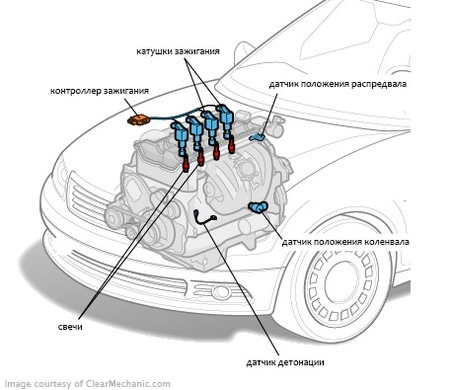
The turn of the key in the ignition and engine starting would seem to be easier. However, this is the view of the driver, and inside the car there are many very important processes in a few seconds. The ignition system consists of dozens of components, but this article refers to the mechanism that connects the wires and closes the contacts necessary to start and stop the engine. This is known as the ignition locking system.
The contact group is a connecting system of electro-conductive contacts, which allows them to close in the correct sequence, thus ensuring the distribution of supply of the current from the power source to the various electrical appliances of the car.
How the ignition control contact group works
The ignition lock itself is an electrical circuit breaker. The key of the ignition switch is the setting of the contact position, thus selecting several options for connection of the chain: starting up the engine, power to the electrical appliances, stopping the engine.
If you remove the ignition switch, you can see the mechanism itself: the lock and the many wires that connect to the plug-receptacle principle. The wires are drawn from the power supply (the battery) and connect all electrical appliances of the motor vehicle into one circuit. The Contact Group acts as a connector for electrical wires. For isolation and segregation, the transactions are fixed in the contact group's plastic body.
Contact Group is required for
In fact, the contact group is necessary for the convenience of connecting all electric circuits of the vehicle, their grouping and replacement in the event of wear. Very often, as a result of the wear and tear of the insulation, the wiring and working circuit of the electro-conductive cables may be broken. It would be possible to connect the contacts directly to the ignition lock, but in this case it would have been necessary to disassemble the lock and to save new contacts each time. It is much simpler and cheaper to replace the contact group.
How the ignition control contact group works
There are two types of ignition systems: battery and generator. The difference is that the battery's ignition has an autonomous power supply and can be included without starting the engine. The Generator Ignition enables the use of electrical appliances only when the engine starts when the electric current is started.
When turning the ignition key, the driver closes the electrical circuit from the battery to the induction coil of the ignition. The electric current passes through the wiring system to the ignition locking system, through the lock pins, goes to the induction coil and comes back to the "plus". At the moment the current passes through the coil, it produces high voltage and serves it on the spark plug. The key therefore closes the ignition circuit contact and starts the engine. In addition to the ignition circuit in the car, there are many other electrical circuits that supply current from the source to electrical equipment. A control group is used to delimit these circuits.
The contacts of the wires are closed with each other by means of a contact group. Each of them is responsible for its electrical equipment group. The key in the lock is rotated to several positions. In position A, the circuit from the power supply to the voltage-distributor and the electrical appliances shall be activated. With battery-ignition, this position may include headlamps, light inside the passenger compartment and use of all electrical appliances. The voltage will be applied directly from the battery to the distributor. If you pivot the key to the next position, the engine starts as described above. The reverse position will stop the engine.
The ignition locking system may vary from one vehicle to another. Many of the vehicles are already at the moment when the key is in the lock. In this case, the presence of the key itself closes the supply circuit. There are many alarms, anti-theft systems, and locking of the car door.
Replacing a contact group
The contact group's burnout is a common occurrence. This usually happens due to the stress of the voltage from one contact to another. When the ignition switch is activated, there are sharp spikes in voltage, especially during engine start up, which results in an increase in the temperature of the electrical wiring material-the insulation material is burned.
In order to keep the contact group safe from fire, you can install an additional discharge relay that will relieve some of the load at engine start. However, for some vehicles, such as Daewoo Nexia, the contact group's burnout is a "chronic disease". In this case, you need to make a replacement.
The contact group should be replaced by simply replacing the old group with a new one, with all contacts being connected to the same scheme as the old one. The connection pattern is in the instructions for use of the car.







